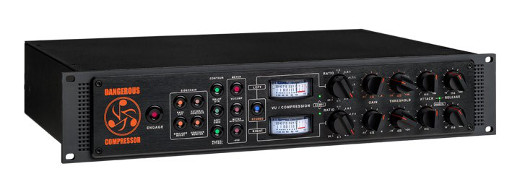Dangerous Music Launches New “Dangerous Compressor” — For Tracking, Mixing & Mastering
The wait is over: One of the most highly anticipated dynamics units in a long time, the Dangerous Compressor from Dangerous Music, has finally arrived.
The result of two+ years of field testing and tweaking, Chris Muth’s latest creation is a dual-mono/stereo compressor for tracking, mixing and mastering. Created to be an “alternative compressor” that would be easy to use, powerful, and transparent, the Dangerous Compressor was made with optimal utility in mind for multiple tasks.
Its controls have a split personality. On the one hand, they’re designed for professionals who prefer manual settings — meanwhile, emerging engineering talents can dive right into various professional “auto” compression modes.
Highly musical as well as transparent, the Dangerous Compressor is available now for a street price of $2799.
Early fans seem to be legion, including Sterling Sound’s iconic mastering engineer Greg Calbi (Tame Impala, The National, Sara Bareilles); record producer/mix engineer Rob Chiarelli (Charlie Wilson, Mary Mary, Kirk Franklin); mastering engineer Jonathan Wyner (Javier Limon, Josh Groban, Nirvana, David Bowie); producer/mixer Michael James (New Radicals, Hole, Robben Ford, L7, Edwin McCain, The Coronas); mastering engineer Alex Saroudakis (Sony music, Universal music, Virgin); mixer Ryan West (Jay Z, Eminem, Rihanna, T.I.); and mastering engineer Mike Wells (Nicki Bluhm and the Gramblers, Tony Sly, and STS9).
From its approach to sidechain to how it handles transient and average level control, the Dangerous Compressor was created to have an identity – and studio functionality — all its own. Here are the full details, direct from Dangerous:
What’s so Different about the Dangerous Compressor?
The ‘Smart Dynamics’ feature employs two independent slopes in the detection circuit. One stage of the detector controls the average level. The other handles only rapid transients. Normally a spike would shove down the entire track, creating an audible faux-pas moment. Instead, with the Dangerous Compressor, the normal slope stage handles the smoothing of the entire content and the other deals with the spikes. This results in a higher average level relative to peak, without the stereo image collapsing.
By default, the unit is set to ‘Auto Attack / Release’ mode which uses time constants carefully selected for versatility. Engaging the ‘Manual Attack/Release’ button allows the manual use of the attack and release knobs.
Transparent
The Dangerous Compressor may be operated in either ‘Stereo’ or ‘Dual Mono’ mode. Dual Mono has two completely independent paths; for example, kick drum in one channel and snare in the other. Stereo Mode may be applied to stereo instruments, stems or complete mixes. Many stereo compressors sum the left and right channel audio and feed that signal to one detector, resulting in any out of phase material will either not get compressed or will be under compressed. This will over-represent mono (content in the middle of the mix) and under represent panned instruments to the VCAs, making normal single-detector compressors potentially overreact to kicks, snares, and the lead vocal while ignoring the panned toms, guitars and keys. The stereo button on the Dangerous Compressor still uses both its detector circuits to drive each channel’s VCA for a more musical result.
The audiophile ‘Sidechain’ circuit offers both Bass Cut – sensitivity reduction to low frequency energy to keep the compressor from “dunking” with loud bass or kick drum levels-and Sibilance Boost, which increases sensitivity to high frequency energy causing the compressor to react more to the top end, taming the harshness without resorting to EQ changes. Users can control sibilance by reducing “S” sounds from a singer or gently tame the harshness from cymbals recorded with cheap condenser mics or poorly sampled loops.
Because of its transparency and audiophile sidechain and detector circuitry the Dangerous Compressor performs like an automated fader for riding vocals: no more manual volume drawing; Just a natural, transparent vocal sound, and it boasts extremely low distortion, even with 20dB of gain reduction.
Please note: When you buy products through links on this page, we may earn an affiliate commission.








Francis Manzella
February 27, 2014 at 7:56 am (11 years ago)Way to go Bob and Chris.. can’t wait to hear it!